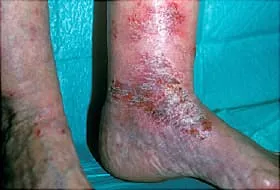Venous stasis dermatitis (also called venous eczema or stasis dermatitis) happens when a problem with your veins, usually in your lower legs, keeps blood from moving through very well. As more fluid and pressure build, some of the blood leaks out of your veins and into your skin. Medical treatments can help, and you can do many things on your own to get the problem under control.
Venous Stasis Dermatitis Symptoms
Swelling around your ankles is often the first sign you'll notice. It might get better when you sleep and then come back during the day when you're active again. Your legs might feel heavy when you stand or walk.
Other symptoms can include:
The skin around or above your ankles looks reddish on lighter skin tones or brown, purple, gray, or ashen on darker skin tones
- Varicose veins, which look twisted, bulging, and dark purple or blue
- Itching
- Pain
- Sores that ooze, crust, or look scaly
- Thickened skin around your ankles or shins
- Hair loss on your ankles or shins
Who Gets Venous Stasis Dermatitis?
The condition is more common in people who are 50 or older. Women are more likely to have it than men. Some conditions that make you more likely to get venous stasis dermatitis include:
- High blood pressure
- Varicose veins
- Being very overweight
- Heart conditions such as congestive heart failure
- Kidney failure
- A blood clot, especially in your leg
- Many pregnancies
- Past surgery or injury in the area
You may also be more likely to have it if you usually stand or sit for long periods of time or don't get much exercise.
What Causes Venous Stasis Dermatitis?
The condition often affects people who have circulation problems. When your veins don't work well, they don't return blood back to your heart the way they're supposed to.
The veins in your legs have one-way valves that help blood move through. Their job is to push blood up your legs. As you get older or have other health problems, the valves may not work as they should. This is called venous insufficiency.
In some cases, this and other conditions can cause pressure to build, causing not enough blood and oxygen to reach the skin.
Venous Stasis Dermatitis Treatment
Because circulation is the main issue, your doctor may suggest surgery to repair your veins. Whether or not that is an option, there are other ways to get the fluid moving in your legs:
- Wear compression stockings. They ease swelling and improve blood flow.
- Keep your feet elevated above your heart. When you can, do it for 15 minutes every 2 hours and while you sleep.
- Don't stand still for too long. Walk around often.
Your doctor may give you a steroid or other medicine to rub on your ankles and legs to treat pain, redness, or swelling. An antihistamine pill or cream might help if your legs are itchy.
You might need to wrap the area with a medicated dressing to help it heal. If you have an infection, your doctor will prescribe an antibiotic pill or cream.
A moisturizer can help with dry skin and keep the area soft. Choose one that has no fragrance, dyes, or perfumes so it doesn't irritate your skin. Petroleum jelly and thick creams can be good options.
How to Control Venous Stasis Dermatitis
A few changes to your daily habits can help you get your venous stasis dermatitis under control and keep it from getting worse.
Take breaks. If your job keeps you sitting or standing for long periods, take time to move. Take a brisk walk for about 10 minutes each hour.
Exercise. Moving makes blood flow better. Ask your doctor how often you should work out and what activities are safe for you.
Wear comfortable clothes. Compression stockings are a good choice for your legs, but choose loose-fitting cotton clothes for the rest of your body. Tight or rough fabrics can irritate your skin and affect circulation.
Take care of your skin. It could become easily irritated. When bathing, use only gentle cleansers and soft towels, followed quickly by a fragrance-free moisturizer. Avoid cleaning products, perfumes, grass, plants, pet hair, or anything else that bothers your skin.
Venous Stasis Dermatitis Takeaways
Venous stasis dermatitis is a condition in which your veins, usually in your lower legs, have trouble pushing blood back to your heart. This causes fluid buildup and blood leakage into the skin, leading to symptoms like swollen ankles, varicose veins, itching, and pain. It's more common in older adults, especially women and those with circulation issues. Treatment involves surgery or medications, along with lifestyle changes such as wearing compression stockings, elevating your legs, regular exercise, and proper skin care.

